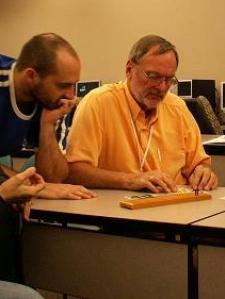81 Answered Questions for the topic AP Calc
05/05/22
Optimization Help and explanation
A Norman window is shaped like a rectangle with a semicircle on top of it. A carpenter has 10m of wood trim and wishes to cover the sides of the rectangle and the upper part of the semicircle....
more
05/05/22
Speedometer readings for a motorcycle at 12-seconds intervals are given in the table.
Speedometer readings for a motorcycle at 12-seconds intervals are given in the table.t (sec) 0 12 24 36 48 60v (ft/sec) 22 26 29 23 23 30(a) Estimate the distance, in feet, traveled by the...
more
05/04/22
Estimate the area under the graph with midpoint?
Estimate the area under the graph of f(x) = 16 - x^2 from x=0 to x=4 using 4 approximating rectangles.I got the right sum = 34 and left sum = 50 but how do I estimate area with midpoints?
05/02/22
integral problem
The velocity function is v(t)=t2−3t+2 for a particle moving along a line. Find the displacement and the distance traveled by the particle during the time interval [−3,6].displacement = ??distance...
more
antiderivative velocity question
A particle moves on a straight line and has acceleration a(t)=18t+14.Its position at time t=0 is s(0)=6 and its velocity at time t=0 is v(0)=14.What is its position at time t=7?
05/02/22
antiderivatives question
Given that the graph of f(x) passes through the point (6,7) and that the slope of its tangent line at (x,f(x)) is 3x+2, what is f(2)?
05/02/22
Find two positive numbers whose product is 144 and whose sum is a minimum? Optimization Help
Find two positive numbers whose product is 144 and whose sum is a minimum.
05/02/22
Optimization Calculus Question
Find two numbers A and B (with A<= B) whose difference is 42 and whose product is minimaized.A = ???B = ???
04/22/22
Derivative integral Please Help
04/22/22
Integral Question
Consider the integral:21∫ x^3 dx3-Use Left Sum, Right Sum, Midvalue Sum, and Trapezoid Rule methods to approximate this integral with n = 3-Find the exact value of this integral
04/19/22
calculus integral question
Consider the integral:21∫ x^3 dx3-Use all three methods to approximate this integral with n = 3-Find the exact value of this integral
11/24/20
FrQ AP CALCULUS
A particle moves along a straight line. For 0 ≤ t ≤ 5, the position of the particle is given by s(t) = 3t + 4t2 - t3.a) What is the average velocity of the particle over the interval 0 ≤ t ≤ 4? b)...
more
01/06/18
How do I solve this? (question too long)
The top of a 15-foot-long ladder rests against a vertical wall with the bottom of the ladder on level ground, as shown above (it's just a ladder leaning against a wall). The ladder is sliding down...
more
10/18/17
Find the derivative using limit process. -3x+2. Find the slope when x=4
i know how to do the derivative part but I don't know what to do with the x=4
02/07/16
Calculus integration question
The rate of depreciation dV / dt of a machine is inversely proportional to the square of t + 1, where V is the value of the machine t years after it was purchased. The initial value of the machine...
more
02/07/16
Use the differential equation and the given point to find the equation of the function. (give your answer correct to three decimal points)
The given point is (-1,3).
The differential is dy/dx= -30/(4x+1)3
02/07/16
Find F as a function of x
The question states:
F(x)= int_1^x(t3+7t-6)dt
( F(x) is the integral of (t3+7t-6)dt from x to 1)
02/07/16
Determine the area under the given curve
The equation is 1/(x8). The limits are x=1 and x=2. I put this into my graphing calculator and it gave me an answer of 0.142 but the answer is not right apparently. Please help!
True or false. If true, why? If false, what is a counter example, and can you explain why it contradicts? Please
If f and g are differentiable and f(x)≤ g(x) on [a,b], then f'(x)≤g'(x) on [a,b]
True or false. If true, why? If false, what is a counter example, and can you explain why it contradicts? Please
If f and g continuous function on [a,b] then (upper: b, lower a)∫f(x)g(x)dx=[(upper: b, lower a)∫f(x)dx]*[(upper: b, lower a)∫g(x)dx].
True or false. If true, why? If false, what is a counter example, and can you explain why it contradicts? Please
If F(x)= (upper: x, lower: 0) ∫√(t3+1)dt then F'(2)=3
find the volume of the solid obtained by rotating the region bounded by xy=4 and y=(x-3)^2 about the x-axis.
finding the volume of the solid
the region bounded by y=0 and y=kx-x^2 is revolved around the y-axis to form a solid whose volume is 10.
what are the exact possible values of k? Hint: use cylindrical shells
exact solution to differetial equation
dy/dy+xy=x , y(0)=1/2
Still looking for help? Get the right answer, fast.
Ask a question for free
Get a free answer to a quick problem.
Most questions answered within 4 hours.
OR
Find an Online Tutor Now
Choose an expert and meet online. No packages or subscriptions, pay only for the time you need.



















